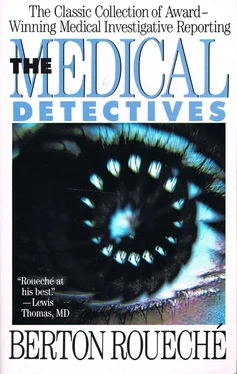As you know, the cause of syphilis also is a spirochete. Not the same one, of course. And untreated syphilis, like Lyme disease, can later reappear, with very serious consequences.
"The laboratory findings were published in Science and in the Journal of Clinical Investigation in 1982 and 1983. And that's about where we stand right now. We have the disease as an entity, we have the causative organism, and we have the vector—the tick. And we have an effective treatment. There are still some loose ends. The most important need is for an effective means of control or prevention. There is a search going on for an immunizing vaccine, but so far without much success. There is a growing demand in the endemic areas for a program to eradicate the tick, for a sanitizing spray. Many of the endemic areas are, of course, resort areas. There are good environmental reasons for opposing that approach. But there is another good, hardheaded reason. A safely selective spray is hard to imagine. And even if there were one it would hardly be worth the trouble. Advocates of a chemical attack on the tick don't seem to fully understand the nature of the tick and its life cycle.
I. dammini is often called a deer tick. Its principal host is the white-tailed deer. That's where the ticks mate. Mating occurs in the fall. The males die after mating, but the females live on through the winter, and in the early spring they lay their eggs in the wild. Then they, too, die. The eggs hatch into larvae, and at some point in the summer the larvae, if they can, attach themselves to a host, usually the white-footed mouse—the field mouse—and help themselves to a big blood meal. Then they rest through the fall and winter. That one meal is all they need. In the spring—the second spring of the cycle—they develop into nymphs. It is in the nymph phase that the tick usually brings the disease to us—if it carries the spirochete, and if it chooses one of us for its meal. The nymph feeds like the larvae—once in a lifetime. But that meal is a big one—a long one, anyway. It gorges for several days. And it seems that only at the end of the meal is the spirochete transmitted to the host. Feeding time can be any time during the summer and early fall. Then the nymph matures into an adult, and mates. It's true that the nymphs can be found on your lawn. But the reservoir is the wild—the field mouse. The field mouse is a burrowing mouse, and you don't often find its burrows in your front yard. You find them out in the woods and scrub. A spray would have to be a powerful spray to penetrate the scrub and soak down into the burrow. It has been generally supposed that the tick finds a suitable host by sensing its animal warmth. It waits on a blade of grass or a shrub, feels the passing warmth, and drops. There is a feeling now, though, that more than heat is involved. It has been suggested that a preferred host exudes a scent, a chemical force of some sort, that incites the tick to drop. Maybe some of us are more attractive to ticks than others. My old dog has had Lyme disease three times. I've treated her just the way I treat my other patients. Of course, dogs range. Proximity to the tick is everything. I've had several cases of Lyme disease in elderly women—old ladies who never got any closer to nature than the front porch. They puzzled me for quite some time. Then I finally figured it out. They all had cats. The cats, being cats, ranged. And cats are mousers. My feeling is that those cats did their mousing at the source—at the burrow. Then they came back home and jumped up on an unsuspecting lap."
I had been thinking about I. dammini's principal host and mating place—the deer. I wondered if the deer might be a crucial factor in any attempt at control. I wondered if the elimination of the deer here on Long Island, or even just on Shelter Island, would break the cycle and abort the disease. Dr. Grunwaldt thought for a moment, and shook his head. "I doubt it," he said. "I think the tick would probably find another host. And, besides, I can't see much public support for a deer-eradication program."
I knew what he meant: What? Bambi?
I know of no one—friend or acquaintance or neighbor—in my part of Long Island who has had Rocky Mountain spotted fever. Nor do I know anyone who has had babesiosis. Lyme disease is a different matter, and this is not surprising. Dr. Grunwaldt told me that he had seen only one case of Rocky Mountain spotted fever in his thirteen years of practice on Long Island, and only twenty cases of babesiosis. But he has seen and treated at least four hundred cases of Lyme disease. I have a number of friends who have suffered its protean rigors. One of them, and one of the local pioneers in this morbid respect, is a woman named Priscilla Bowden (Mrs. Jeffrey Potter), an artist, an amateur flutist, and a knowledgeable gardener. Miss Bowden, a slim, dark-haired woman in her forties, lives with her husband on a verdant acre in the village of East Hampton, with expanses of lawn and many shade trees and flowering shrubs in a pleasant surround of woods. They have—or had at the time she took sick—a small brown dog and a large white cat. Her illness, she told me in a talk we had at her home, had its beginnings just after the Fourth of July weekend in the summer of 1982.
"It was July 7," she said, glancing at a sheaf of papers. "A
Wednesday—I keep a diary. It's not a 'Dear Diary' diary, it's just a kind of social record, but if something interesting happens I make a note of that, too. Well, I'd been feeling mean for a couple of days. Not actually sick, but just not feeling well. I blamed it on the big weekend of the Fourth. Summer weekends here are always a strain. Too many parties. So I dragged around, and then, all of a sudden, it struck. It started with a headache—a horrible, terrible headache. And I felt burning up. I took my temperature. It was 103.5 degrees. That was around midafternoon. At around seven, I took it again: 104 degrees. That was pretty frightening. I went to bed and spent a miserable night. I was still burning up the next morning. Jeffrey called Dr. Medler—Raymond Medler, in East Hampton. We were given his first available appointment: one o'clock. When I got there, I didn't have to say much. Dr. Medler took my temperature. It was 104.6 degrees. He said he didn't know what was wrong with me, but with a fever like that the only place for me was the hospital. And right away. I said can't I even go home and get my toothbrush? He said no, that I should go straight to the hospital—Southampton Hospital. So I went.
"I was fortunate enough to get a private room. My headache was horrible. They got me into bed, and Dr. Medler arrived and started me on aspirin. It was amazing. In a couple of hours, my fever was down to 99.9 degrees, and my headache had practically vanished. I felt well enough to ask for some paper and a pen; and I started making these notes. Then the aspirin wore off and my headache came back and my fever went up to 102.5 degrees. They seemed to go together. First the fever, then the headache. Or maybe it was the other way around. My memory is a little hazy about those next few days. I made my notes, but the details are a little dim. Dr. Medler and the nurses kept asking me if I remembered having a tick bite. I said no—not as far as I knew. It was somewhere around that time that they began to speak of Lyme disease. I don't think I'd ever even heard of Lyme disease. I wrote that down in my notes, only I wrote '1-i-m-e,' and 'arthritis.' That's what they called it then. They asked me about a rash. I hadn't noticed any kind of rash, and I didn't have a rash then. Not at that moment. That was Thursday and Friday and Saturday. My fever went up and down, and so did the headache. Then, on Sunday, there it was—a rash. It was a circular red rash, about three or four inches in diameter. It was on my leg, my thigh. Then I saw two more circles, also on my leg. One of the nurses found another one, on my back. So now it was established. I had 'lime arthritis.'
Читать дальше












